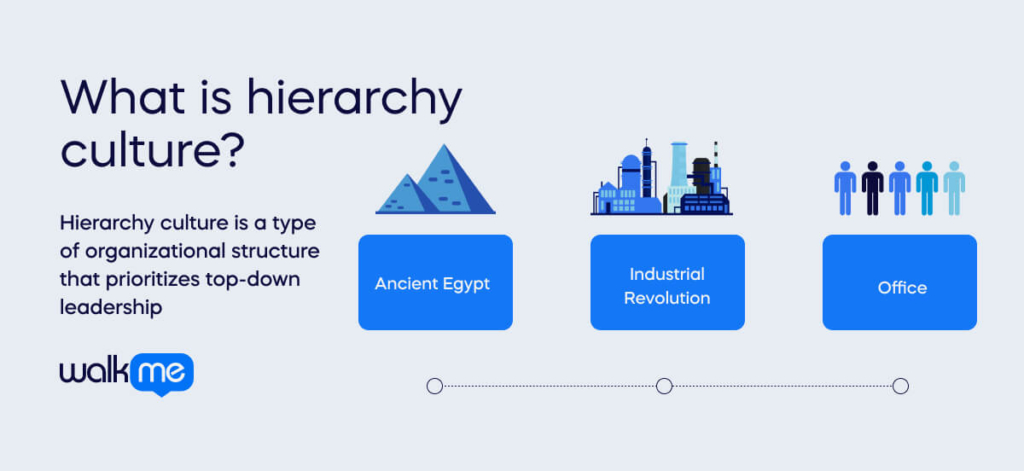Company culture is the bedrock of any successful business. From new hires to high-seated executives, it’s integral for HR to assess how their organization is, well, organized. And for many businesses, a hierarchical office culture may be the best fit.
But contrary to what some might believe, this culture didn’t begin in the office. The roots of hierarchical culture stretch back to Ancient Egypt, and it became widespread across businesses leading up to the 20th century, especially following the Industrial Revolution.
So, what exactly is hierarchy culture? And how and when can the model benefit your business?
We’ll cover the ins and outs of hierarchy culture for HR: its benefits and challenges, as well as show you can implement this model effectively.
What is hierarchy culture?

Hierarchy culture, also known as hierarchical culture, is a type of organizational structure that prioritizes top-down leadership. It establishes clear levels of authority within a company, shared core values, and internal predictability.
Most HR experts agree there are four types of organizational culture. Alongside hierarchy culture, the three other culture types include adhocracy culture, clan culture, and market culture.
Key characteristics of hierarchy culture
But what exactly makes a workplace a hierarchy? Below are some key characteristics of historical culture.
A workplace governed by clearly defined rules and policies
Clearly defined rules and policies are the foundation of hierarchy culture. Employees must adhere to predetermined guidelines and protocols in a hierarchical office environment to maintain smooth operations.
While some may argue rigid rules and policies are outdated, clear rules can help employees better understand their responsibilities and help hold all employees accountable for their actions.
These clearly defined guidelines are implemented across all management levels, not just new hires. Prioritizing adherence to rules aims to mitigate risks, prevent errors, and manage failures effectively. It also ensures that rules and consequences are equitable for all employees within the company, regardless of their position.
Clear top-down control system
In hierarchical organizations, stability, and control are paramount. This is why hierarchy culture emphasizes a clear top-down management system.
The design of hierarchical organizations begins with the CEO at the top, followed by middle management and team leaders overseeing team members. Typically, roles are structured into various departments or divisions, each with distinct duties and responsibilities.
Each division possesses its level of authority and decision-making autonomy over those beneath it in the chain of command. For example, a marketing department will have a clearly defined control system separate from other divisions. The head of each department holds decision-making authority over subordinates.
A clear chain of command is established to save time and boost productivity and stability. A well-defined chain of command can help avoid confusion and lead to more coordination.
Decisions made at the top level are typically expected to be followed without input from lower ranks. Communication primarily occurs between superiors and subordinates, with minimal interaction among colleagues outside their respective teams or departments.
A focus on individual achievement over team effort
In hierarchical cultures, individual performance tends to be rewarded over collective action or interdepartmental collaboration. This means that working harder and putting in extra hours are more likely to be recognized and rewarded.
Hierarchical offices maintain clear separations of roles, ensuring that each person within the organization has a specific job to fulfill. They also clearly define the responsibilities of each employee, often with rigid KPIs and goals.
While this allows HR and upper management to reward individual employee’s achievements, it can also limit creativity and innovation. Employees may lack engagement and feel constrained by their assigned roles, leaving them less inclined to explore new ideas or approaches.
Are there real-world examples of hierarchical culture?

Hierarchical culture is employed throughout countless organizations. Here are a few examples of how hierarchy is used today.
IBM
IBM, a leading global technology company, has traditionally upheld a hierarchy culture throughout its workforce. An essay published by the Cambridge University Press, which covered the history of this tech giant, emphasized the longstanding presence of hierarchical structures within the company.
While this organizational rigidity has provided stability over the decades, it has also drawn criticism. In the 1990s, IBM encountered financial challenges with a staggering $16 billion decrease in revenue between 1991 and 1993. The essay notes that, at the time, Louis Gerstner, former CEO of IBM, described the company culture as “deeply inbred and ingrown” during this period of turmoil.
McDonald’s
But hierarchical culture isn’t just limited to the tech world, it also plays a role in the fast food industry. Take McDonald’s for example, where rigid roles are implemented throughout the organization: from drive-thru staff to suited-up higher executives. In hospitality, operations need to tick like clockwork.
McDonald’s has a divisional, top-down hierarchy culture where each division, based on geographical location, is assigned operational responsibilities and strategic objectives. At the top is the CEO (currently Chris Kempczinski) and the board of directors. Below them are separate functional departments like marketing, finance, operations, supply chain, human resources, and so on.
Customers know what to expect when they order from McDonald’s. The consistency of your burger, both in flavor and service, is key. Establishing a top-down chain and command is the best way to keep things efficient and consistent.
It also established a clear framework for new hires to train and work up the company. Just like its food, hierarchy ensures the McDonald’s machine stays well-oiled.
IKEA
The e-commerce industry also benefits from a hierarchy culture. Take IKEA, for instance, a titan in the household goods industry. But it hasn’t earned this global success by chance. It’s a result of deliberate strategies and effective management within a hierarchy culture.
Managing a global company like this requires effective delegation of responsibilities. Not only is an IKEA store massive, but the sheer number of staff and products it sells is astronomical. The e-commerce giant has 351 stores spanning 46 countries, each store stocks approximately 10,000 different products, with an additional 2,000 new ones introduced annually.
A hierarchical model allows smaller teams to be placed under separate management, ensuring attention to detail across different teams and products. However, it’s worth noting that IKEA balances its hierarchy with a more informal, collaborative work environment. This helps to promote teamwork across the board and sets the Swedish company apart from similar businesses.
HSBC
Money talks and banking is serious business. Large financial institutions like HSBC often adopt a hierarchy culture throughout their operations in the finance sector, where stability and formality are important.
As the largest European bank by total assets, HSBC traditionally organized its operations into three main global business groups: Commercial Banking, Global Banking and Markets, and Wealth and Personal Banking.
This top-down approach to management not only ensures smooth operations but also provides trainees with the opportunity to establish themselves within the company and progress through the ranks.
However, In recent years, HSBC has recognized the limitations of its global hierarchical culture. In 2021, reports emerged that HSBC was preparing to overhaul its entire senior management structure as part of a streamlining initiative aimed at moving away from the hierarchical model that had been in place for decades.
What are the benefits of hierarchy culture?

There are countless benefits to a hierarchical culture. Below we’ve listed a few.
Consistency in company values and communication
The root of any successful business is its organizational values. Companies that lack a guiding principle to direct their actions and decisions are like a ship sailing without a compass, unable to navigate effectively toward its desired destination. Consistent values throughout every layer of an organization are key. And that’s where hierarchical culture comes in.
The rigid nature of hierarchy culture establishes consistent values throughout an organization, whether it’s a small startup or a global brand. Having a clear mission statement and a collective drive throughout the company can boost employee engagement across the board.
It can also improve communication throughout a company, too. Hierarchical culture promotes clear communication within an organization by assigning each specific roles and responsibilities. This clarity makes it easier for employees to understand what is expected from them.
Creates a framework for employee growth and loyalty
But it’s not just about values and communication. A hierarchical culture is an effective way of establishing a clear framework for employee growth. It’s all about the big picture.
When new hires join an organization, they’re not just assessing the initial job role. They assess the prospects of growth within the company too. That’s where the structured nature of hierarchy comes in handy.
With clearly defined roles and responsibilities, employees understand their position within the company and also how they can progress. Similar to a ladder, the hierarchical structure offers a framework for employees to climb upward. This can be highly motivating, particularly when combined with shared company values.
Hierarchy also gives employees a sense of security, as they understand their position and feel valued accordingly. It boosts employee morale, increasing productivity and efficiency among staff members.
Streamlined decision-making
In a hierarchy culture, there’s no ambiguity as to who calls the shots. Decisions are made by upper management and are communicated down the chain of command. While other cultural models may have an added level of bureaucracy, decision-making in a hierarchical culture is relatively simple.
This is why hierarchy culture is popular amongst global companies with a large workforce. Decisions can be made quickly and efficiently, without delays caused by discussions or debates.
Efficient delegation of tasks and increased productivity
Delegation is another major appeal for a hierarchical model. Unlike other forms of company culture, a hierarchical structure is black and white. It allows task delegation where a company sees fit and ensures clarity within the roles of an organization.
This delegation method can greatly boost productivity. By assigning specific responsibilities to individuals, everyone understands their role and deadlines. This organizational clarity enables employees to specialize in particular areas, leading to higher-quality output. The clear chain of command also allows better clarity around accountability. For instance, if a team misses a deadline, it’s easy for higher management to pinpoint where improvement is needed.
Stability which is popular among investors
The future is unpredictable. However, a hierarchy culture adds stability that other company cultures lack.
In times of adversity, such as unforeseen events or a challenging business quarter, a hierarchical culture enables organizations to prepare for and adapt to challenges effectively. Hierarchy can help organizations weather a storm. If layoffs are needed, it provides a clear framework for management to assess productivity across teams.
And this works the other way too. The stable framework of hierarchy culture also enables management to evaluate departments performing exceptionally well and warrant further development. For this reason, hierarchy is popular among external investors. When investing in a company, investors seek stability rather than volatility.
What are the challenges of hierarchy culture?

However, despite the benefits of a hierarchy culture, there are also challenges.
Limited employee empowerment
The rigidity of a hierarchical structure can lead to employees feeling powerless and lacking a sense of purpose in their work. No one wants to feel like a robot, but unfortunately, due to the strict hierarchy, many employees in the company may feel so.
Hierarchy can often foster a sense of stagnation, especially when subordinates are given little opportunities for advancement or recognition due to predetermined job roles.
Hierarchy culture reinforces power dynamics between management and employees. While this structure has benefits, it can also decrease employee engagement.
Workers may feel alienated, believing their contributions are undervalued or unappreciated by upper management.
Furthermore, it may exacerbate feelings of inequality, as those in higher positions may enjoy more privileges or opportunities than those in lower positions.
Slow response to change
A hierarchy culture is also resistant to change, making it challenging for the organization to adapt to new technologies or evolving market conditions. In an age of remote working and AI technology, the workplace is changing now more than ever – those who stick to hierarchy might be left behind.
While this is particularly true for the tech sector, a slow response to change is a detriment to any industry. Moreover, decisions often require approval from higher-ups on the corporate ladder, causing delays for projects and initiatives.
Communication barriers and a lack of creativity
Communication issues are also a major drawback to a hierarchical model. While rigid systems can benefit management in making key decisions, they can also create communication barriers between different levels within the company.
Employees may feel disconnected from upper management and disempowered, leading to reduced job satisfaction and increased turnover.
A lack of communication between different departments within the workforce can also hinder creativity and innovation. Senior management may be less likely to consult with lower-level staff when making decisions, which can restrict the flow of new ideas.
Highly competitive
In a hierarchical culture, individual achievement often takes precedence over teamwork. While this can be a benefit, it also has its drawbacks too. After all, a company can benefit from a healthy dose of competition within its workforce.
However, when taken too far, it can also create an atmosphere that hinders collaboration and teamwork. The highly competitive culture brought by hierarchy can result in a lack of cohesion among employees, decreasing employee engagement and productivity amongst teams.
How to employ hierarchy culture in an organization effectively
Create an open environment with clear expectations
Organizations should strive for a workplace where employees feel empowered to share their ideas and offer feedback. Clear expectations for employees are essential for the success of a hierarchy culture, so promoting this environment is crucial.
Establishing clear expectations for each employee ensures that everyone understands their roles, responsibilities, and the goals they should work towards. Failing to do so can leave new hires feeling aimless and lacking purpose.
It’s also important to establish a clear framework for employee progression within the company. This can be accomplished through various methods, including one-on-one coaching, training sessions, and employee development programs guided by clear KPIs.
Focus on inclusion
Workplace hierarchies often leave employees feeling excluded or undervalued based on their position or rank within the organization. Decisions made only by those at the top may streamline the process, but it’s crucial to ensure that those lower down feel empowered to contribute and have a voice in it.
Establishing company-wide meetings, where all employees have the opportunity to voice their ideas, is an effective way to foster inclusion. If feasible, implementing regular one-on-one meetings between management and employees to assess progress and provide feedback on company progress should also be considered.
Establishing a hierarchical culture that maintains its stability while also mitigating feelings of alienation among the workforce is key.
Promote teamwork through a collective sense of purpose
As mentioned above, one of the key aspects of hierarchy culture is its tendency to focus on individual achievement. And while this is a benefit in motivating employees to fulfill their job roles, it can also be a drawback too.
Too much priority for individual achievement can hinder teamwork and cohesion within the company, resulting in lower employee engagement and staff feeling alienated.
That’s where a collective sense of purpose comes in. By ensuring your company has a collective goal to work towards, employees have a drive to work toward something bigger than themselves, which can lead to greater job satisfaction and better performance over time.
Acknowledge employees’ achievements
A collective sense of purpose is not the only thing that can drive employee engagement and boost productivity in a hierarchy culture. Recognizing the achievements of your workforce can also be highly effective.
A hierarchical culture can often foster a cold and formal environment, where employees lower down the ladder feel unrecognized for their hard work. This is particularly true for large companies with many chains of command.
Establishing an employee recognition scheme can enhance your workplace’s overall culture and foster innovation and creativity within roles.
Organizations adopting this model must invest in an effective employee development program that rewards achievements and incentivizes teams to achieve their goals.
When should you employ a hierarchy culture in an organization?
So, when should HR employ a hierarchy culture in their organization? Well, the answer isn’t clear-cut. Hierarchy has numerous benefits and drawbacks compared to other methods of corporate culture. But, ultimately, it depends on your business: its goals, values, size, and industry.
That said, there are some key pointers to guide you in this decision.
- Hierarchy culture is commonly employed in large, often global, businesses. This is because hierarchy enables effective management across expansive networks, where decision-making involving all employees would be convoluted or impractical.
- It is used in formal sectors where stability is highly valued. Think finance, insurance, accounting, and telecommunications. These industries often have little margin for error and have clearly defined goals to achieve.
- Hierarchy culture may not be suitable for businesses on a smaller scale. Organizations such as startups in the tech, content creation, and arts sectors, where rapid and holistic decision-making across teams is valued, may need a more balanced model.
- Creative industries may not be well-suited for hierarchical culture too. Many employees within this industry increasingly value flexible working arrangements, which a hierarchical culture may not easily accommodate.
- It’s also important to assess the age of your workforce, too. In a recent survey of 20,000 Millennials and Gen Z individuals, the characteristics of organizational success, flexibility, and adaptability were ranked the highest. These characteristics are the opposite of what hierarchical culture provides.
Ultimately, hierarchical culture remains one of the most widely used forms of office culture today for good reason. It provides consistency in company values, streamlined decision-making and productivity, and, most importantly, stability. However, unlike centuries ago, hierarchical culture isn’t the only option for HR to consider.


